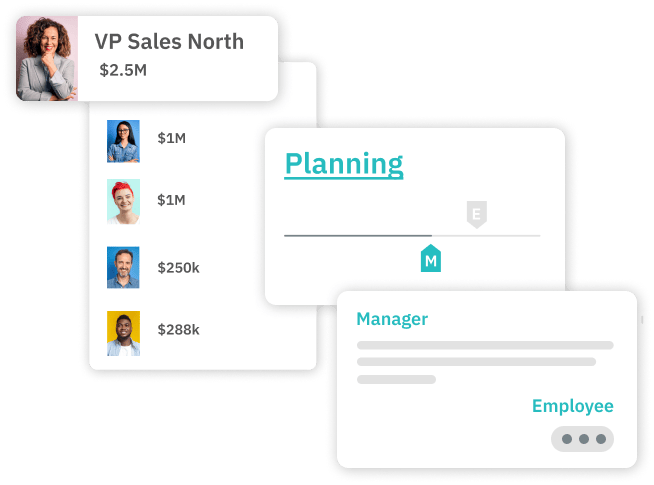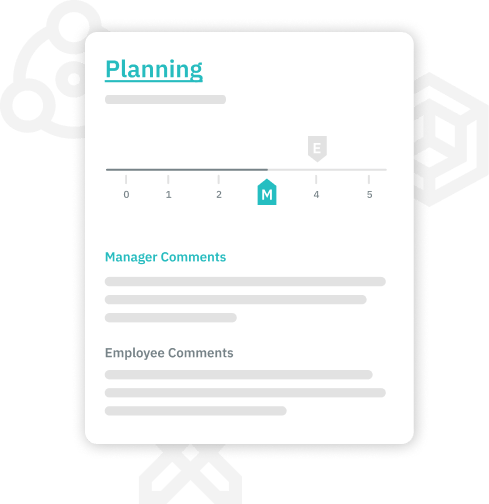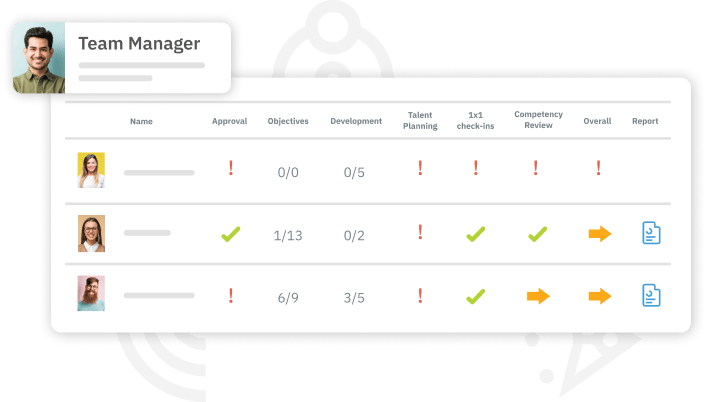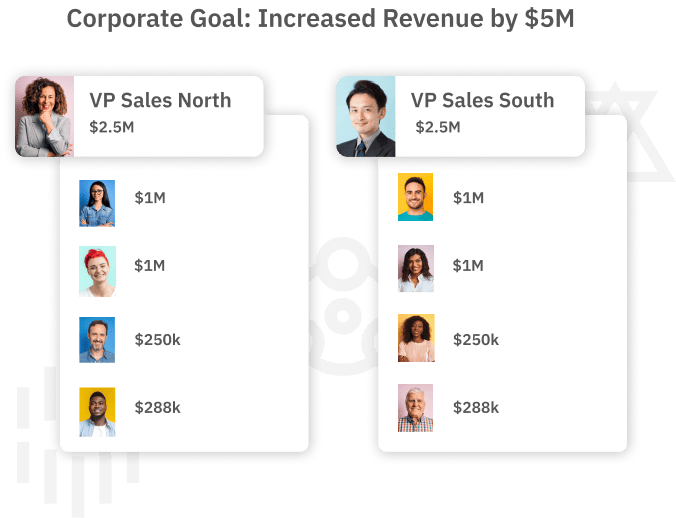Performance Management Tools
Ongoing feedback, continuous growth
Turn periodic performance reviews into an ongoing conversation that generates constructive feedback and meaningful, measurable improvement throughout the year.


Real-time feedback for better learning
Performance feedback is most powerful when it happens in real time, whether it’s constructive criticism or recognition for a job well done. The performance review can be transparent between manager and employee or employee-only, or manager-only.

Multi-faceted reviews
Combine reviews of culture, soft skills, job skills, and organizational goals into one streamlined performance review. Utilize BARS or Likert scales to customize to your organizational needs.

Org-wide goal alignment
Keep everyone working towards the targets that matter by setting company or departmental goals and assigning them directly to employees.
Get Your Free Demo & See our Platform in Action
Select from one of the bundles below and we will tailored the demo to your needs. Let us show you how TalentGuard’s solutions adapt to your industry.
Automate
Competency management for HR with AI automation. Create AI-powered skills, jobs, and career paths, building a strong talent management foundation.
Automate includes:
- WorkforceGPT Copilot powered by Generative AI
- Talent Frameworks: Access to industry-specific pre-built competency models
- Content Management System: Ability to create, edit, manage and map skills, jobs, learning and career progressions.
- Workflow and Approvals Automation
Engage
Enhance employee engagement and retention with impactful strategies that ensure optimal return on investment.
Everything in Automate plus:
- Talent Assessment: Assess employee skills and competencies
- Development Plan: Develop personalized learning paths
- Career Path: Advance employees with recommend career paths
- Analytics: Workforce intelligence insights and reporting
Optimize
Build a robust enterprise foundation to manage and optimize your mission-critical talent management program at scale.
Everything in Engage plus:
- Succession Planning: Build high-potential talent pools
- Performance Management: Review, set goals, & provide feedback
- Certification Tracking: Track employee certifications
- 360 Feedback: Conduct multi-rater leadership feedback
Trusted by:




Your workforce is changing. Never be unprepared again.
Read our eBook
Additional information
One of the best things an organization can do is to have a performance management plan in place. Performance management isn’t something that begins and ends but is an ongoing process that works to improve expectations and performance by having structured, individual and team goals aligned with the company’s strategic people plan. By using performance management tools, everyone can develop the knowledge, skills, and abilities to successfully move forward.
The performance management application shifts depending on who administers the system. A few performance management issues include a shortage of the right talent, lack of effective evaluation methods, lack of clarity in vision, failure to create objectives, and the wrong tools. To find the best performance management system, an internal checklist should be part of the equation. A few considerations:
- It should align with your business goals.
- It should be user-friendly on all levels.
- It should place a high priority on training and development.
- It should seamlessly integrate with other systems.
- It should provide real-time data.
With the shift in the way people work, the future of performance management looks different. Performance management trends indicate that employee goals will be both personal and professional, pay decisions and reviews will be based on performance, reviews won’t be as stringent and will have more context, feedback and development information will be automated, team performance management will be isolated, and managers will no longer be the sole decider of performance.
This means the hybrid workplace continues to take center stage, where inclusivity is a must, and teams have more autonomy and accountability for what they do. This means organizations must have the right tools and resources in place to be successful.
Performance Management System
When you have a good performance management system in place, things work better. Many organizations fail to realize the importance of performance management system accountability. You don’t want a culture where things are in chaos and employees feel as if their contributions aren’t valued.
There are different types of performance management system methods to ensure the performance management tools and techniques are unique to the company and best fit your strategic goals. These performance management techniques are popular, and these seven performance management techniques examples may already be used within your organization together or as individual components:
- Performance Appraisals
- Balance Scorecards
- Personal Development Plans
- Key Performance Indicators (KPIs)
These are performance management system examples that may guide your overall plan:
- 360-Degree Appraisals
- Employee Self-Assessments
- Manager Performance Review
Taking a look at some performance management best practices and examples can help direct your steps or provide a basis to improve your current performance management process.
Performance Management Process
Since the performance management process is designed to keep employees engaged, retain the talent you currently have, and develop your leaders internally, it’s vital to really understand how managing performance at work helps the organization. Companies are learning to embrace new standards and shy away from the outdated formal performance management process. There is a six step performance management process that can help your organization be successful:
- Embrace training and development
Your managers must be trained on how to deal with different types of people, your culture, and other organizational management protocols. It is not good to assume that a manager will automatically know how to effectively manage. - Move away from annual appraisals
Having regular meetings with your employees to discuss performance and other issues makes a huge difference because the process is ongoing, rather than waiting an entire year to address things. - Align with the organization’s overall strategic goals
Proper development for future growth means your talent’s personal and professional goals should be aligned with the company’s objectives. - Invest in culture
Your company culture is a direct reflection of good or poor performance management. Make sure everyone is championed instead of just select employees. - Remain transparent
The team deserves to know what’s going on within the company. That starts with open communication.
These steps will enhance any types of performance management processes you consider, as well as performance management process examples you may want to mirror.
Performance Management Framework
A good performance management framework is a combination of company goals and employee development. Skills intelligence, skill tracking, and skills assessments help build out a complete picture of your talent, the areas where they can thrive, and ways to help them consistently develop.
What exactly is a performance management framework?
There are different types of performance management framework examples to consider. Overall, this is a breakdown of your key internal processes and priorities. The best employee performance management frameworks have components from all areas of the organization. Here are a few types of performance management framework tools that drive success:
- 360-degree Feedback
Everyone that works with the employee will be able to chime in on how the employee is doing, what they may need to work on, and more. This helps create a development plan for success. - MBO (Management by Objectives)
This framework has four components – goals that can be achieved but are challenging; continuous feedback; rewards for following best practices and achieving objectives; and consistent focus on personal growth and development - HR-review-driven Performance Analytics
This is effective in that it helps record evaluations and measure engagement and interest. - Balanced Scorecard
This document ranks categories based on objectives to evaluate metrics like alignment with company goals, performance matches expectations of internal and external stakeholders, and performance consistently improves. - OKR (Objectives and Key Results)
This is when objectives and key results are set for the employee to achieve. They are timebound but are not set in stone as some of them may be too lofty to achieve during the set time.
Performance Management Software
There are manual ways to track performance management, but using dynamic performance management software that updates with internal data, market trends, and changes is the most comprehensive and intuitive way. Continuous performance management software can help store data, run reports, find high performers, and provide management with a way to check in throughout the employee’s journey.
There are quite a few systems that fall into the top performance management software category. The best performance management software can only be determined by the user because the decision is based on whether the software meets all their needs.
Having an effective performance management and appraisal system that embraces the future while providing your team with the information they need is ideal. It is important to note that all performance management tools are unique in their own way, helping track performance in a consistent, measurable way to help meet overall business and people goals.
